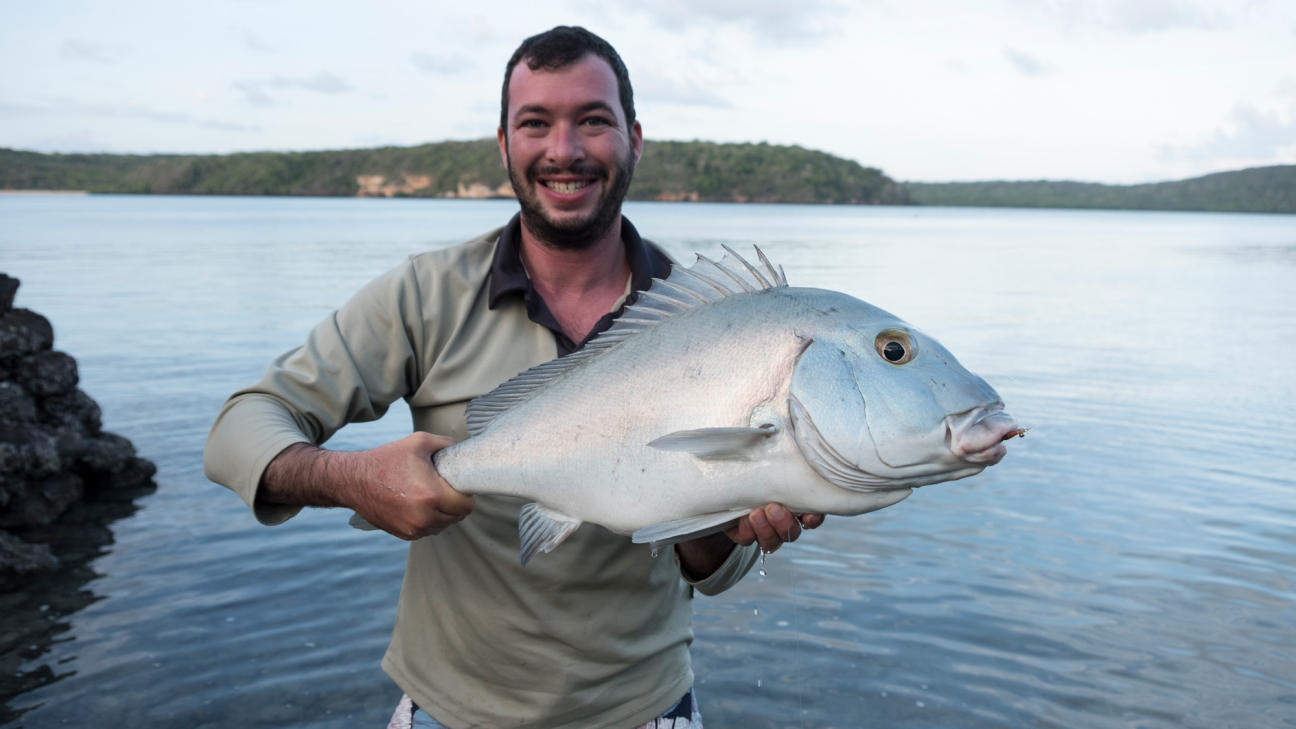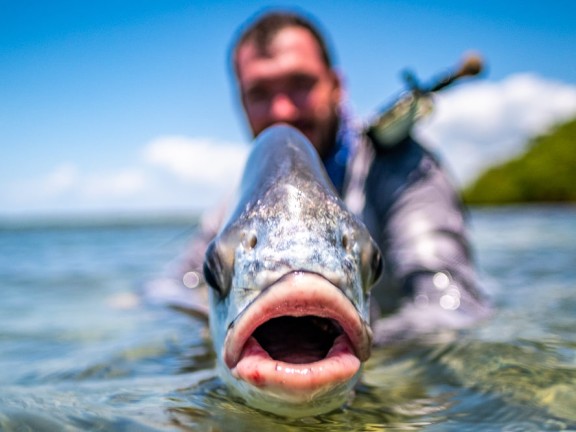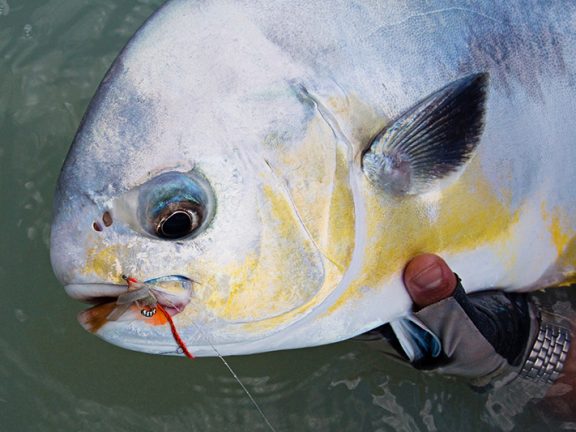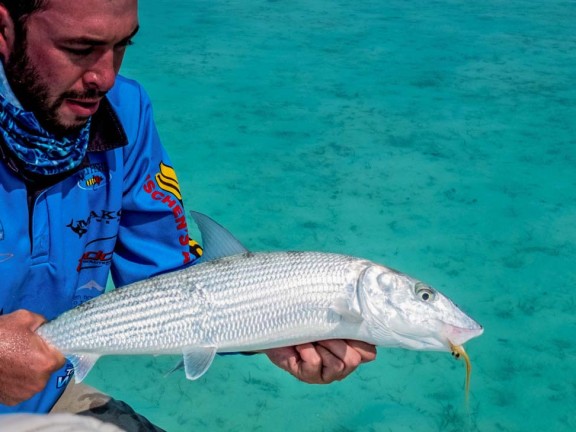Having been introduced to the world of saltwater fly fishing while living in the southern hemisphere, my exposure to various species has been a little different than most of you.
I have had the opportunity to explore much of the Oceania region, and from my personal experiences, I have found that the bottom half of the globe has so much to offer the saltwater fly angler. From the recently recognized “Blue Bastard”, to the hard hitting “ray riders” of New Zealand, these under appreciated species should be on your radar in 2020.

Yellow-Tail Kingfish
Only a few years back an entirely new fishery was discovered in New Zealand.
Yellowtail kingfish from 5kg – 30kg were found right up on the shallow flats of several harbors, often seen riding off the backs of large stingrays. They have become known as “ray-riders”, and in certain salty fly circles are becoming one of the most sought after targets! If you can handle the cold water, yellow-tail kingfish are best targeted on foot; chucking poppers over the tops of stingrays. The fishing often requires the angler to make long casts, but once a kingfish zeroes in on the chug of a popper, its game on! These brutes will take you into your backing within seconds, heading for the closest bit of cover… which often means you!
Why: Big, strong, aggressive fish that you can sightcast with poppers in shallow water…. Need I say more?
Best locations: New Zealand
Top Flies: Large poppers

Golden Trevally
I remember my first days on the water is Australia. I waded around the flats, dodging sharks, crocs and nudists (wish I was joking), hooking nothing but the back of my head.
Golden trevally were my target and it would take weeks before I was able to land my first fish. It’s not that they are terribly challenging to catch, but as a solo angler with nearly zero saltwater experience, I had a lot to learn. Goldies, as they are known in Australia, venture onto the flats as the tide falls to about knee high, and will stick around until right before the water becomes too shallow for them to swim. On the incoming tide, they will do the opposite, moving into the flats as soon as the water is able to cover their body; sticking around until the tide reaches knee height.
Being a trevally species, they will cruise quickly through a flat similar to GT, and stop every 15-30 yards to feed – head down, tail right out of the water like a bonefish or permit. While cruising, intercepting fish with a stripped shrimp fly generally works, however, when goldens are tailing, crab flies work best.
Why: Because GEETs are soooo 2015… Just joking, goldens have the fight of a GT with the feeding behaviour of a bonefish. Think of them as a somewhat dumbed-down permit!
Best locations: Australia
Top Flies: VGDC, Bauer crab, ultimate shrimp, Jono makim’s spawning shrimp

Milkfish
Just might be the toughest fish to catch on fly. This long torpedo shaped fish has a massive forked tail, which accounts for nearly half of their length.
Milkfish feed on plankton, and are best targeted along wind or current lines where they can be spotted scooping mouthfuls of seemingly invisible organisms from the surface film. Casting a small algae fly or scud pattern into a pod of feeding fish is generally how most milkfish are hooked. When you do manage to hook one, be warned they take off and just don’t stop. Make sure you are prepared with at least 300m of backing and a strong set of arms. Fun Fact: milkfish don’t build up lactic acid!
Why: Pound for pound toughest fighter on the planet!
Best locations: Seychelles, Australia, Christmas Island
Top flies: Arno’s milky dream, reverse olive woolly bugger

Niugini Black Bass/Spot Tail Bass
While Niugini Black Bass and Spot Tail Bass are two distinct species, they are often targeted synonymously.
These catadromous snapper species are found in the remote tidal river systems of Indonesia, Papua New Guinea and the Solomon Islands. I first became infatuated with these fish while working as a fisheries consultant in a remote corner of the Solomon Islands. While my initial attempts to catch one of these fish on fly failed, I have since found multiple systems where these amazing fish are present and I am pleased to report I have managed to land a handful on fly. While locating these guys is not overly difficult, they are some of the toughest fish to land. Both snapper species are often found tucked into submerged timber, often around heavy currents. Black Bass and Spot Tails will dart out past your fly, turn 180s degrees, and hit it on their way back into their snags. Once a fish get back into cover its game over – you will not be able to get them out. To catch one, you will need to be on-point, and once the fish takes your fly, you must hold your ground and not give an inch. If you are to slow, or caught off guard, they will literally rip the fly line out of your hands. This is close quarters combat at its finest.
Why: These fish get absolutely massive, and hit flies harder than any other fish I caught. They are simply badass!
Best Locations: Papua New Guinea, Solomon Islands (spot tail only)
Top flies: Giant bunny flies with weed guards, yak fur baitfish, poppers and spook flies for top water
Being a trevally species, they will cruise quickly through a flat similar to GT, and stop every 15-30 yards to feed – head down, tail right out of the water like a bonefish or permit. While cruising, intercepting fish with a stripped shrimp fly generally works, however, when goldens are tailing, crab flies work best.
Why: Because GEETs are soooo 2015… Just joking, goldens have the fight of a GT with the feeding behaviour of a bonefish. Think of them as a somewhat dumbed-down permit!
Best locations: Australia
Top Flies: VGDC, Bauer crab, ultimate shrimp, Jono makim’s spawning shrimp

Blue Bastard
First recognized as a unique species in 2015, the “Blue Bastard” is finally starting to get the respect it deserves.
For years, this fish was unknown to anglers outside of a small fraternity of North Queensland anglers. I first started targeting bastards while studying marine biology at James Cook University in Townsville, Queensland. They can be a tough fish to catch, but just like any other fish, once you understand their habits and patterns, they are attainable. Blue Bastards are usually found around shallow coral heads and reef rubble, particularly on low tide. They tend to hover across the flats, mainly feeding on polychaete, hermit crabs, and snails. Bastards are finicky, smart, and aware of their surroundings, but will take a small shrimp or crab fly if presented properly. The best place to cast is right in front of the fish, but be wary not to cause too much of a splash. Similar to fishing permit, use a short strip to get the fish’s attention, but once the fish sees your fly – keep it still – as any movement may spook the fish. To set the hook, I watch for the fish’s reaction rather than feeling the bite. When I see the eat, I start a long, slow strip to tighten the line. Once I feel weight on the end of the line, I set hard.
Why: Tough, finicky, fish that take off like a freight train once hooked!
Best locations: Northern Australia, particularly the top of Cape York
Top Flies: Merkins, VGDC, ultimate shrimp, fuzzy worm



